9 /10 1 Votes
Genre(s) Manic shooter Cabinet Upright Initial release date 22 May 2008 Developer CAVE | 9/10 Steam Mode(s) Single-player Arcade system CAVE CV1000D Series DonPachi Designer Kouji Ogata | |||||||||||||||||||||||||||||||||
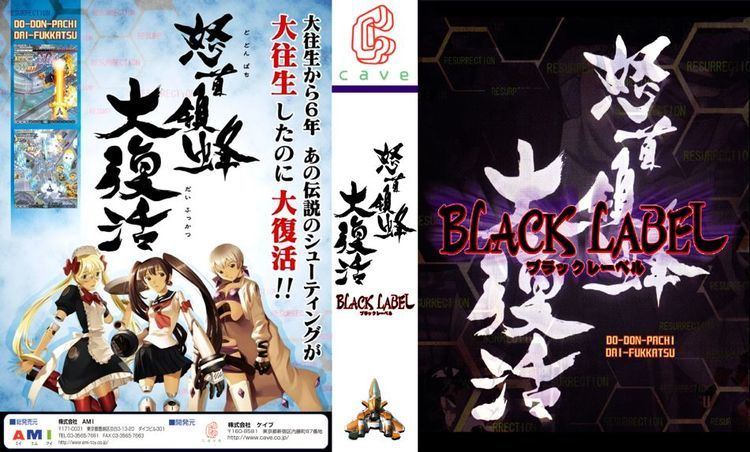 | ||||||||||||||||||||||||||||||||||
Composer(s) Manabu NamikiAzusa ChibaYoshimi Kudo Release date(s) May 22, 2008ArcadeJP: May 22, 2008Version 1.5JP: June 24, 2008Xbox 360JP: November 25, 2010EU: November 4, 2011Black LabelJP: February 3, 2011iOSWW: August 26, 2010AndroidJP: October 2011EU: October 2011NA: TBAMicrosoft WindowsWW: October 14, 2016 Similar CAVE games, Shoot 'em up games | ||||||||||||||||||||||||||||||||||
DoDonPachi DaiFukkatsu (怒首領蜂 大復活, - lit. Angry Leader Bee Great Resurrection) is the fifth arcade game in Cave's DonPachi series. The game was publicly unveiled at AOU2008 Amusement EXPO.
Contents
- Dodonpachi daifukkatsu black label bomb mode 1cc with type b and ex boss cave arcade pcb 2010
- Gameplay
- Plot
- Development
- Black Label
- Music
- iOSAndroid
- Xbox 360
- Microsoft Windows
- References

Dodonpachi daifukkatsu black label bomb mode 1cc with type b and ex boss cave arcade pcb 2010
Gameplay
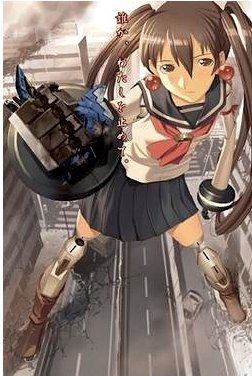
Reversing the fighter selection of the last game, the element daughters in this game are boss characters, appearing as giant women at the end of each stage.
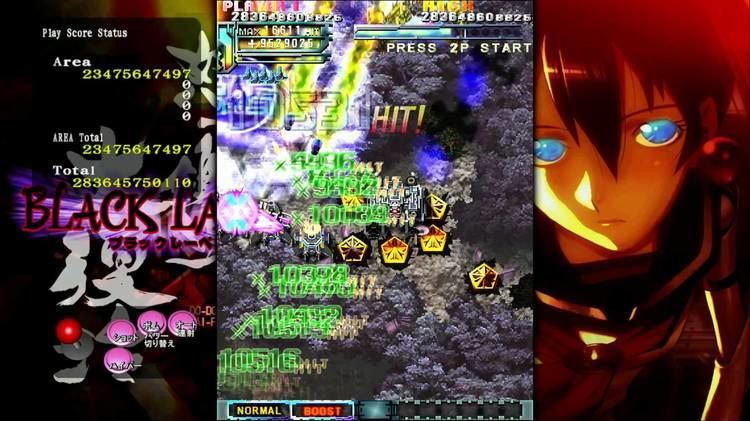
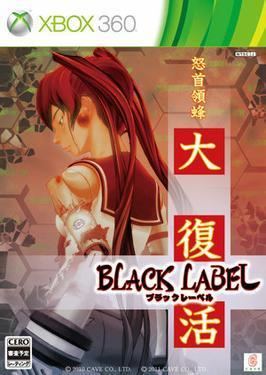
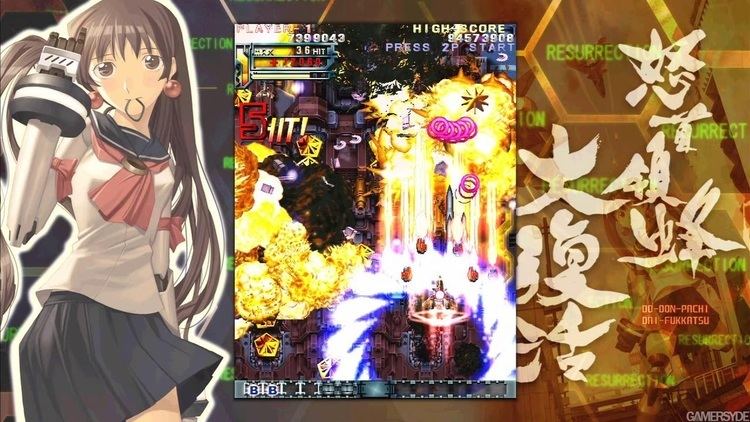
This can be activated when the hyper counter gauge is full. During activation, the player's attack can destroy enemy bullets until the gauge is depleted. The gauge can be recharged by destroying enemies.
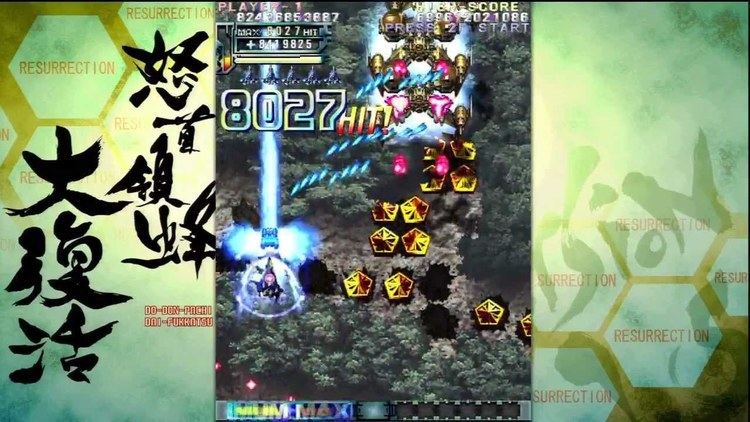
When using the laser, it can block weak lasers fired from enemies, but not strong lasers if boost mode is not used. When the hyper counter is activated, the player's laser can block both laser types in either shot style.
There are two paths for each stage, with the second one being accessible under certain conditions; should the appropriate requirements be met, the bosses from the original DoDonPachi will reappear as mid-bosses with upgraded graphics and fiercer attacks. Hibachi, the series' trademark true last boss, only appears after completing stage 5 for the second time in an Ura loop and destroying its war-machine form Taisabachi (an interesting pun, since the translation is Colonel Bee and it's indeed piloted by Longhener himself), its Supreme Killing Weapon (極殺兵器, Gokusatsu Heiki) - Hibachi core capable of extremely brutal attacks and, a series' first, counterattacks whenever the counter laser is used. As usual, a protective shield is deployed around Hibachi whenever invincibility is granted to the player, in the form of a bomb or hyper activation. For less skilled players, an easier second loop can be accessed meeting less tight requirements (namely collecting 35 hidden bees and not using a continue, or not more than one death regardless of how many bees collected), whereas the Ura loop demands collection of all 45 hidden bees, no more than 1 death and exploding no more than two bombs.
Plot
After the turmoil caused by the assault on Lunapolis which sparked the "Blissful Death Wars" (as depicted in the previous installment), peace seems to have been restored, with the legendary DonPachi Corps retreating to its HQ in a space-time fold. Six years later, anomalies are detected in the space-time fabric, yet tests reveal nothing out of order, with the portals regularly functioning for both teleportation and time travel; also, the leader of the DonPachi squadron Colonel Godwin Longhener dismisses the matter due to the lack of actual danger.
Nevertheless, a technician delves deeper into the anomaly, discovering that something has infiltrated the HQ computer systems and is using the portals to send large quantities of materials and data to the past, spreading out like a virus and quickly evolving. In an ironic twist, the virus is discovered to be the program originally installed in the Element Dolls six years ago, now reaching beyond the DonPachi Corps programming and seeking to annihilate the human race in retaliation for their "enslavement" (after the war, they met a rather cruel demise at the hand of their own human creators) by waging war in the past rather than in the present: unsettled, the Colonel authorizes the last transport ship to time jump in order to fight back the invasion before future changes. However, he states: "Start over from the past... I never thought of that", echoing the ideas of mankind's imperfection which has always been a recurring theme in the series.
And once again, the three pilots jump back in time to 2008 and enter the fray, the transport ship being targeted as soon as it exits the portal: the Element Daughters, gigantic evolutions of the Dolls, are awaiting...
The bee is still humming.
After clearing the game's Ura loop, the entirety of the plot is revealed: one of the Dolls, EXY, interfaced with the enemy computer network at the end of DaiOuJou, managing to shut it down but succumbing to madness soon thereafter. Overwhelmed by the sea of new information, she turned against her human pilot, killing him and herself and becoming the parasitic virtual entity detected by DonPachi HQ; still following her original programming, she created the Element Daughters and the robotic army featured in the game in a desperate attempt to destroy the installation that would start the chain of events leading to the Blissful Death Wars - presumably, DonPachi Corps HQ itself at the time of the elite squadron's birth. Exploiting their deranged plan for salvation, Colonel Longhener manipulated the Element Dolls/Daughters into destroying order and civilization, convinced of its intrinsic imperfection and aiming towards rebuilding it according to his idea of flawlessness (an attempt already foiled centuries before by the first DonPachi Squadron). Said ambitions come to an abrupt halt with the destruction of the ultimate fighting machine Hibachi.
As the pilot jumps back to the future he comes to finally realize how, instead of preventing the bloody future depicted in the series, EXY Next actually triggered it: he/she is forced to watch, powerless, as Longhener is appointed as the commanding officer of the DonPachi Corps with the rank of General, the Daughters standing beside him - the date being just a few years before the start of the Blissful Death Wars. Everything had been for nothing.
Development
The initial arcade release. Was replaced with Ver.1.5.
Cave replaced the initial release PCBs with Version 1.5 for free which includes the following changes:
This PCB only has made one public appearance - at the 2010 Cave Matsuri Festival. It has a different scoring system to Ver.1.5, only features one loop, only features 3 buttons instead of 4 (hyper and bomb are on the same button, like in DoDonPachi Dai-Ou-Jou. There are other differences as well.
Black Label
This version, released in January 2011, contains following known changes:
The soundtrack of the game includes a track called "Zatsuza", which was rumored to be the theme for another last boss under even stricter conditions. This was officially confirmed by CAVE. Zatsuza replaces Hibachi as the true last boss.
Music
iOS/Android
An iOS version of the game was released on August 26, 2010 via the App Store, called DoDonPachi Resurrection. This is a port of Dodonpachi Daifukkatsu version 1.5. There are additions such as an iOS exclusive mode and the ability to play as Hibachi after certain conditions. In addition to the regular soundtrack, the iOS exclusive soundtrack is included. This version was ported to Android in 2011 for the G-Gee service and released internationally in 2012.
Xbox 360
Version 1.5 was also released on the Xbox 360 in Japan on November 25, 2010, in both standard and limited editions. This port does not contain a choice between arcade and high resolution graphics as per previous Xbox 360 Cave ports, it only includes the high resolution graphics. The modes included are: Xbox 360 (Arcade), Novice, Arrange A (ver L), Arrange B (ver B). Version 1.51 is available exclusively in the first-press versions as bonus DLC. Black Label (including a Black Label Novice mode, but NOT Black Label Arrange) is available as 1200 point DLC. The limited edition features a different cover and an arrange soundtrack CD. A Platinum Edition release has been confirmed for 2012. These releases are all region locked to Japan. This version was released in Europe as Dodonpachi Resurrection, see below.
Rising Star Games published Dodonpachi Daifukkatsu Ver 1.5 in Europe and PAL territories in November 2011, under the title Dodonpachi Resurrection: Deluxe Edition. This includes Xbox 360 (Arcade), Novice, Arrange A (ver L), Arrange B (ver B). Version 1.51 is available as 80 point DLC. Black Label (including a Black Label Novice mode, but NOT Black Label Arrange) is available as 800 point DLC. The game features the cover of the Limited Edition version of the Japanese Version 1.5 release and includes the arrange soundtrack CD that came with that version.
Black Label
The Black Label version was released on the Xbox 360 on February 3, 2011. The Xbox 360 version of Black Label also includes an Arrange Mode and featuring crossover content from Ketsui, including the ability to play as the TigerSchwert and to face down against a new far more powerful Evacannia DOOM (Known as HIVAC), as well as Zatsuza. A.I, one of the Element Daughters, is seen in promotional Artwork posing like Alice from Ketsui. The content comes in two forms, the first is a downloadable version which can be used with 1.5's retail version not including the Ketsui content, the second is a standalone retail game which contains the Ketsui content. The soundtrack for the Ketsui game is an arranged version from Ketsui itself and those with the retail disc can customize the music in game between 1.5, Black Label and Ketsui Arrange as they wish. The Black Label Xbox 360 disc contains Black Label, Black Label Novice and Black Label Arrange modes. It does NOT contain version 1.5.
Microsoft Windows
The Microsoft Windows version was announced during Cave Matsuri event on April 26, 2016, and released on Steam on October 14, 2016. This version contains all previously available contents from the Xbox 360, including the Version 1.51 which was a paid DLC on European release, and the Japan-only exclusive Black Label Arrange Mode, as well as a soundtrack.
